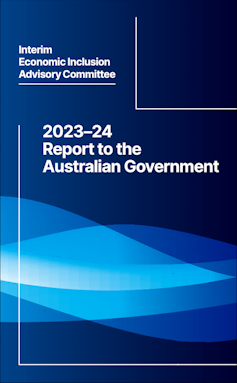
What was Treasurer Jim Chalmers thinking?
Late last year he set up a committee he specifically asked to tell him how bad JobSeeker was.
The exact words in its terms of reference required it to advise him on the “adequacy, effectiveness and sustainability of income support payments”.
It is true that he was sort of forced to. Independent Senator David Pocock made the committee a condition of supporting an unrelated industrial relations bill in the Senate. Its findings had to be published a fortnight before each budget.
Yet Chalmers chose to set a group whose findings would be hard to ignore. He put on it one of Australia’s pre-eminent experts in the adequacy of payments, Professor Peter Whiteford; one of Australia’s pre-eminent experts in labour markets, Professor Jeff Borland; and one of Australia’s pre-eminent experts in calculating disadvantage, Associate Professor Ben Phillips.
To give the “interim economic inclusion advisory committee” extra heft, he added the head of the trade union movement, the head of the Businesses Council, the head of the Council of Social Service and the head of the Treasury.
In short, Chalmers set up a committee he couldn’t ignore. So why is he now so keen to talk about everything but its number one recommendation?
Impossible to ignore
Sometimes committees like these end up making so many recommendations that a minister can pick and choose from them.
And this committee did make 37 recommendations, as Finance Minister Katy Gallagher noted this week saying she was “not going to be able to do everything”.
But, unusually, this committee went out of its way to make sure one recommendation stood out above all others.
It reported that, given its short timeframe, it had:
decided to concentrate on the needs of the largest
number of Australians experiencing poverty and disadvantage today, namely people
on JobSeeker, Youth Allowance and related working-age payments.
It found every available indicator showed the current rates of JobSeeker and related payments were seriously inadequate, whether measured against payments overseas, against the minimum wage, against pensions, or against poverty lines.

Report of the Interim Economic Inclusion Advisory Committee
Measured against other members of the Organisation for Economic Co-operation and Development, Australia’s JobSeeker payment for a newly-unemployed single was the third worst.
When the higher rates of rent assistance available overseas were taken into account, it became the absolute worst.
Whereas a quarter of a century ago Australia’s unemployment payment was roughly in line with the pension, decades of lifting one in line with prices and the other in line with wages have left us with a base JobSeeker rate of $347 a week ($49.50 per day), compared to a base age pension of $485 a week ($69 per day).
Too little to get medicines or work
Job seekers told the committee that $347 per week is so low, they kept looking around their homes for things to sell. Some had to choose between medicines and electricity. Some could fill only some of their prescriptions. Others could barely afford the petrol to get to medical appointments.
The committee’s findings echoed those of the OECD, which found 12 years ago Australia’s unemployment payment had fallen so low compared to costs as to raise “issues about its effectiveness” in helping the unemployed find jobs.
The committee’s number one recommendation – more important than any other – was that the government
as a first priority, commit to a substantial increase in the base rates of the JobSeeker Payment and related working-age payments
It didn’t ask for JobSeeker and associated payments to be lifted to the pension rate straight away, although it did suggest that the ultimate goal should be 90% of the pension. Ben Phillips has calculated that would cost $5.7 billion per year, which is less than 1% of total government spending.
What the committee didn’t want was a tiny increase along the lines of the $25 a week ($3.60 per day) the Coalition delivered when the coronavirus payments ended in 2021, without a commitment to build to something substantial.
So what is the government now doing in response? Chalmers and Gallagher appear to have decided it’s best to talk about something else.
Changing the subject
Seven News has reported that, while it won’t touch the base rate of JobSeeker and associated payments, the Albanese government will increase the rate for Australians aged 55 and over who have been out of work for some time.
That’s even less of a commitment than it seems.
There are 920,640 Australians on JobSeeker and Youth Allowance (which is a lower rate of JobSeeker for young Australians and is also paid to apprentices and students). Only 236,280 of them are aged 55 and over.
Many of those 236,280 are aged 60 and over, and already get a boosted JobSeeker payment; an extra $26 per week ($3.70 per day) after they have been out of work for nine months.
Read more:
Top economists want JobSeeker boosted $100+ per week, tied to wages
If all Chalmers is planning is to extend the extra for the long-term unemployed aged 60 and over to the long-term unemployed aged 55 and over, it will cost little, and deny the vast bulk of those on $49.51 per day hope that things will improve.
Chalmers appeared to verbal his committee on Tuesday by saying it had found women over 55 are the most vulnerable group amongst unemployed Australians.
While the committee did say that (and while 56% of the Australians on JobSeeker in that age group are women), it could not have been clearer in recommending that the base rate of JobSeeker and associated payments be lifted for all Australians.
Chalmers says we ought to wait to see what is in the budget, which is fair enough. But if a commitment to do what his personally-selected expert committee has recommended isn’t in this budget, that committee is likely to recommend it again two weeks before the next budget, and again two weeks before the next.
The treasurer has put himself on notice.
Post a Comment